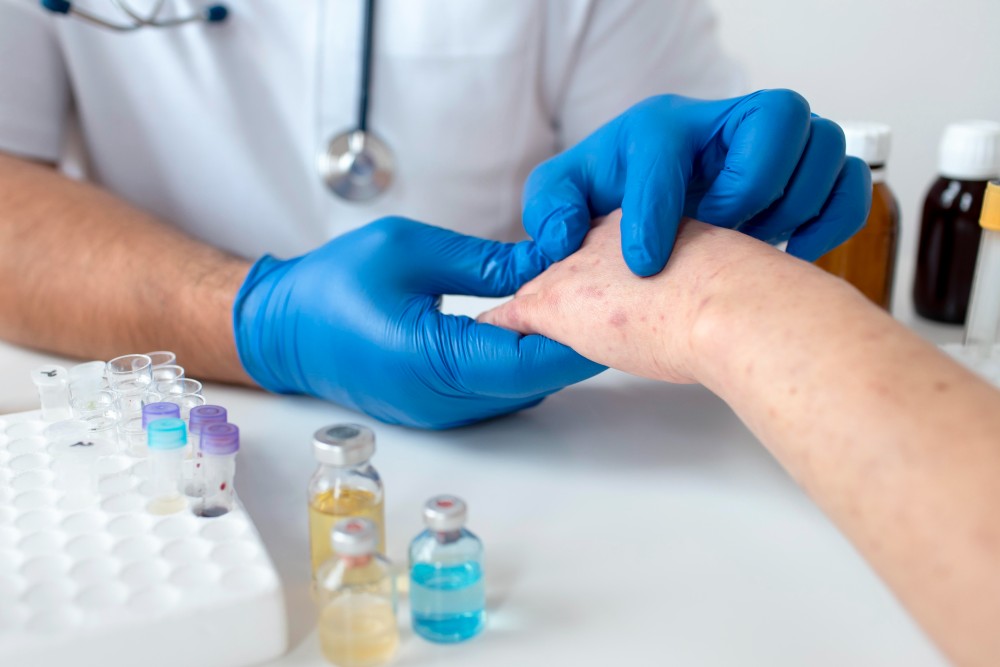For millions of people, a runny nose, itchy eyes, or skin rashes are a part of daily life. These symptoms, while often manageable, can significantly impact quality of life. The first step toward finding relief is understanding what’s causing the reaction. That’s where allergy skin testing comes in—it’s a simple, effective, and quick method for pinpointing the exact substances, or allergens, that trigger your symptoms.
What is an Allergy Skin Test?
An allergy skin test is a medical procedure used to determine if your immune system overreacts to specific substances. During the test, a healthcare professional exposes your skin to small amounts of common allergens, such as pollen, pet dander, or certain foods. The test works on the principle that if you are allergic to a substance, your body will have a localized, mild reaction at the test site. This reaction, typically a small, raised bump or hive, confirms a positive result.
There are several types of skin tests, but the most common are:
- Skin Prick Test (or Scratch Test): This is the most frequently used method. A small drop of a suspected allergen is placed on the skin (usually the forearm or back), and the skin is then gently pricked or scratched to allow the allergen to enter the surface. Multiple allergens can be tested at once.
- Intradermal Test: This test involves injecting a tiny amount of an allergen just under the skin’s surface. It is more sensitive than the skin prick test and may be used if the initial prick test results are negative but a strong allergy is still suspected, particularly for things like insect venom or penicillin.
- Patch Test: This test is used to diagnose contact dermatitis, a delayed allergic reaction that appears on the skin after contact with a substance like a specific metal or chemical. Patches containing allergens are taped to the skin and worn for 48 to 96 hours.
The Testing Process: What to Expect
The procedure is quick and generally involves minimal discomfort. Before the test, your doctor will ask you to stop taking certain medications, especially antihistamines, which can interfere with the results.
On the day of the test, the process usually follows these steps:
- The healthcare provider will clean the skin on your forearm or back.
- Small marks will be made to identify where each allergen will be applied.
- Tiny drops of different allergen extracts are placed on your skin next to the marks.
- The provider will use a lancet to lightly prick the skin through each drop. You may feel a slight, momentary pinch.
- After about 15-20 minutes, the provider will examine your skin for any reactions. A positive reaction will look like a small, red, itchy bump, similar to a mosquito bite.
The results are immediate, allowing you and your doctor to discuss a diagnosis and a potential treatment plan right away.
The Benefits of Getting Tested
Allergy skin testing is a critical tool in managing your health. By identifying your specific triggers, you gain the knowledge needed to take control of your symptoms. The key advantages include:
- Accurate Diagnosis: Skin testing is considered the gold standard for allergy diagnosis, providing a reliable way to confirm what you are allergic to.
- Personalized Treatment: Knowing your triggers allows your doctor to create a tailored treatment plan, which may include avoidance strategies, medications, or even allergen immunotherapy (allergy shots).
- Improved Quality of Life: By effectively managing your allergies, you can reduce or eliminate bothersome symptoms, leading to better sleep, improved productivity, and an overall better sense of well-being.
- Differentiation from Other Conditions: Allergy symptoms can often mimic other illnesses, such as a cold or asthma. Testing helps differentiate between these conditions, ensuring you get the correct treatment.
Conclusion
Living with allergies doesn’t have to mean a life of constant discomfort. Allergy skin testing provides a clear, objective path to understanding what’s causing your symptoms. By taking this simple step, you can work with a specialist to develop a plan that not only manages your symptoms but empowers you to live a healthier, more comfortable life. The immediate results and accuracy of the tests make them an invaluable part of your journey toward relief.
Frequently Asked Questions (FAQs)
Q1: Is allergy skin testing painful?
A1: The procedure is generally not considered painful. You may feel a slight, momentary pinch or a mild itchiness at the test sites, but it is typically well-tolerated by adults and children alike.
Q2: How accurate are the results?
A2: Skin prick tests are highly accurate for diagnosing immediate-type allergies. However, a positive result simply indicates a sensitivity. The results are always interpreted in the context of your medical history and symptoms to provide a complete diagnosis.
Q3: Can children get allergy skin tests?
A3: Yes, allergy skin testing is safe for people of all ages, including infants. It is often performed on the back of children for ease and convenience.
Q4: Do I need to stop taking my medications before the test?
A4: Yes, your doctor will provide specific instructions, but it is typically required to stop taking antihistamines and certain other medications a few days before the test, as they can suppress your body’s reaction and lead to inaccurate results.
Q5: What happens after the test if I have a positive result?
A5: Your doctor will discuss the results with you, identify your triggers, and work with you to create a personalized treatment plan. This may include a combination of avoidance strategies, medication, or immunotherapy to help manage your allergies.
Ready to get to the bottom of your allergy symptoms? Visit our website https://scchouston.co/allergy/ to learn more about our comprehensive allergy testing and treatment services. To schedule a consultation with our experienced team, please don’t hesitate to call (281) 741-3204. We’re here to help you breathe easier and live a life free from the burden of allergies.

